Since we first visited Perugia nearly twenty years ago, it has been one of our favorite cities. Well, actually since we second visited it several years later did it became one of our favorite cities. Our first visit was one of those trips where you feel like shouting out “Mulligan” or “Do over” as you watch it recede in the rear view mirror.
Our second visit to Perugia definitely cemented it as one of our favorite Italian cities and this fact contributed greatly to our decision to buy our villa in the nearby village of Cannara. What is it that we find so appealing about Perugia? Its haunting beauty. Its uniqueness. Its vast sweep of history. Its modern beating heart. In Perugia you can eat well, soak up incredible architecture, learn about human history, listen to jazz, gaze at breathtaking vistas and enjoy people watching. Perugia has everything you could possibly want.
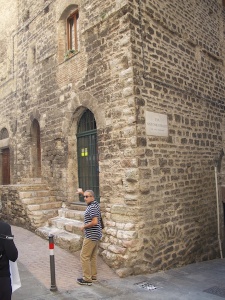 One of the amazing features of Perugia is the long, illustrious history it has been a part of. Founded over 2500 years ago by the Etruscans, Perugia still bears testimony to these people and their civilization that completely vanished from the earth leaving very little trace of its existence. But sitting high on a commanding hill, Perugia proclaims “I am Etruscan.” Perhaps it says, too, “hear me roar.”
One of the amazing features of Perugia is the long, illustrious history it has been a part of. Founded over 2500 years ago by the Etruscans, Perugia still bears testimony to these people and their civilization that completely vanished from the earth leaving very little trace of its existence. But sitting high on a commanding hill, Perugia proclaims “I am Etruscan.” Perhaps it says, too, “hear me roar.”
Two incredible monuments to the Etruscan civilization are still found here – the massive city walls, made from perfectly cut and perfectly enormous slabs of stone. The city’s Etruscan entry gate may not catch your attention, but once your attention is drawn to it, it is hard to imagine how a civilization hundreds of years before Christ could design and build such a thing.
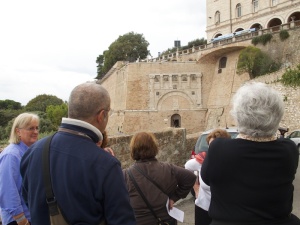 On the other end of town, the archway that marked the other city gate is displayed on a brick wall that was built in the late 1500s. It is one of the five oldest arches in Europe and with its portico of statues seems to be saying, “Welcome to the Etruscan town of Perugia.”
On the other end of town, the archway that marked the other city gate is displayed on a brick wall that was built in the late 1500s. It is one of the five oldest arches in Europe and with its portico of statues seems to be saying, “Welcome to the Etruscan town of Perugia.”
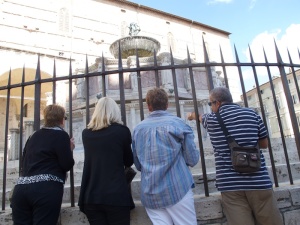 Moving to a more modern age, Perugia prospered and flourished as a major independent power in the middle ages. And nothing marks that ascendency more than the Fontana Maggiore, the medieval fountain that dominates the main square on the Corso Vannucci, in front of the city’s main cathedral. The fountain, constructed in 1278, marked an amazing municipal accomplishment, the transporting of drinkable water into the city from springs over five kilometers outside the city, located across a valley from Perugia. The technological achievement of designing and building an aqueduct that could carry water such a distance – and uphill – makes one rethink the notion that the middle ages were a great big human time out.
Moving to a more modern age, Perugia prospered and flourished as a major independent power in the middle ages. And nothing marks that ascendency more than the Fontana Maggiore, the medieval fountain that dominates the main square on the Corso Vannucci, in front of the city’s main cathedral. The fountain, constructed in 1278, marked an amazing municipal accomplishment, the transporting of drinkable water into the city from springs over five kilometers outside the city, located across a valley from Perugia. The technological achievement of designing and building an aqueduct that could carry water such a distance – and uphill – makes one rethink the notion that the middle ages were a great big human time out.
The middle ages saw an expansion not only of Perugia’s power and influence, but an expansion of its territorial limits, as well, as the line of the original Etruscan walls was expanded outward to create a larger city.
Perugia continued to be an important center during the renaissance, but one which, unfortunately for its ruling elite, ran afoul of the favor of the Pope. Seeking to claim this strategic central Italian city and add it to his league of Papal States, Pope Paul III conquered and occupied Perugia in the latter half of the 1500s. Deciding to build an enormous garrison to house his occupying troops, he unwittingly created one of the great tourist attractions in central Italy, the rocca paolina, an underground complex of ancient roads and buildings that were sealed up when he built his fortress above the medieval city’s streets and existing buildings. Today modern escalators whisk pedestrians from parking garages in the outskirts of town through this subterranean maze and into the historic center of town. It is one of the most interesting, haunting and unique experiences imaginable.
And what of Perugia today? That is perhaps what makes it such an appealing 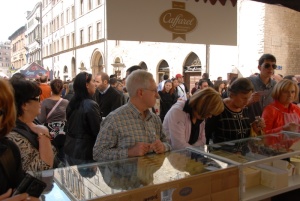 town. Within all of this history lives an incredible beating heart. Modern Perugia is alive, buzzing, in constant movement. Perugia University houses tens of thousands of students. High end fashion shops line the main pedestrian walkway. There are galleries, restaurants and bars. People hang out on the stairs of the cathedral drinking a beer and (of course) smoking a cigarette. Chocolate is made not just at local favorite Perugina but by a host of other small artisanal producers and celebrated every year at the annual Eurochocolate Festival, bringing visitors from across Europe and the world. And each summer the Umbria Jazz Festival plays host to the world’s best jazz musicians.
town. Within all of this history lives an incredible beating heart. Modern Perugia is alive, buzzing, in constant movement. Perugia University houses tens of thousands of students. High end fashion shops line the main pedestrian walkway. There are galleries, restaurants and bars. People hang out on the stairs of the cathedral drinking a beer and (of course) smoking a cigarette. Chocolate is made not just at local favorite Perugina but by a host of other small artisanal producers and celebrated every year at the annual Eurochocolate Festival, bringing visitors from across Europe and the world. And each summer the Umbria Jazz Festival plays host to the world’s best jazz musicians.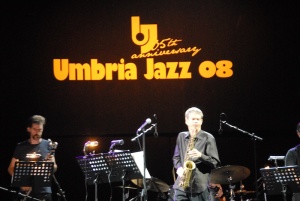
And so Perugia is a living city, vitally so, but it is also a living history museum. Everywhere you look there is an archway, a niche, a wall that signifies something, if you know where and how to look.
Such is the case with a little archway leading to the town’s new minimetro tram system, another step the city fathers have taken to make the city even more friendly to pedestrians and convenient for those who drive to the city by car. During our walking tour of discovery of Perugia yesterday, after being shown the sweep of history of this amazing city by our equally amazing tourguide Francesco, we stopped for just a moment in front of an innocuous little archway, an archway that gave cover to the entrance to the escalator leading down to the minimetro.
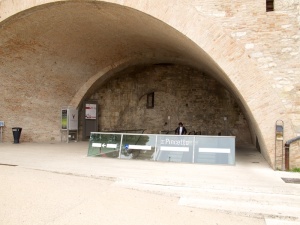 Here, for those with the ability to see it, is the confluence of four tides of Perugina history. Like the waves of separate rivers rolling into one, cancelling each other out, here is an intersection of the Etruscan, the middle ages, the renaissance and the modern. Here there is a corner of the original Etruscan walls, built over 2500 years ago with its enormous stone blocks, and coming off those original city walls, the smaller brick walls of the city’s medieval expansion built some millennium and a half later. And this intersection is shored up by renaissance arches over which the city’s original university building is perched. And finally, disappearing into the underground of Perugia is an escalator that carries present day Perugini to and from work and about their lives that make this incredible, historic city a living monument to those who have built and continue to build this town.
Here, for those with the ability to see it, is the confluence of four tides of Perugina history. Like the waves of separate rivers rolling into one, cancelling each other out, here is an intersection of the Etruscan, the middle ages, the renaissance and the modern. Here there is a corner of the original Etruscan walls, built over 2500 years ago with its enormous stone blocks, and coming off those original city walls, the smaller brick walls of the city’s medieval expansion built some millennium and a half later. And this intersection is shored up by renaissance arches over which the city’s original university building is perched. And finally, disappearing into the underground of Perugia is an escalator that carries present day Perugini to and from work and about their lives that make this incredible, historic city a living monument to those who have built and continue to build this town.
And that, along with dozens of other reasons, is why Perugia is one of our favorite cities.
Ci vediamo!
Bill and Suzy




About The Author
Related Posts
27 Years of Happiness and Adventure
Studio Alice le Maschere